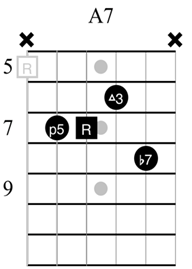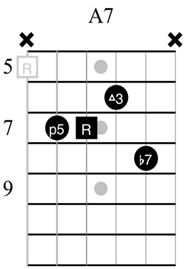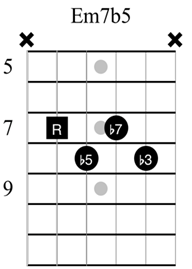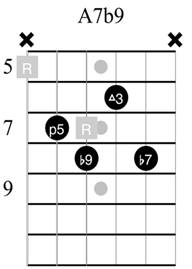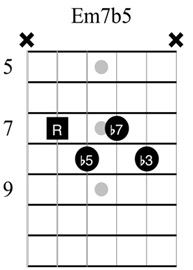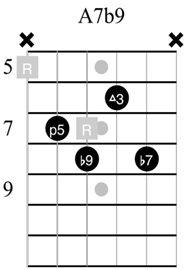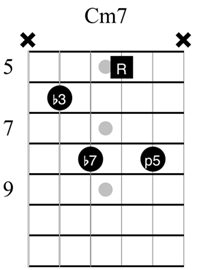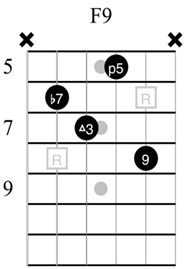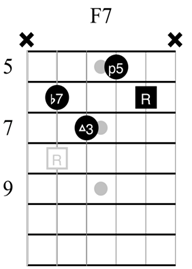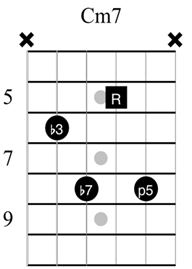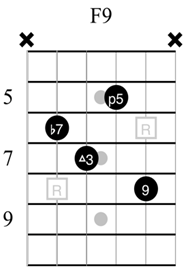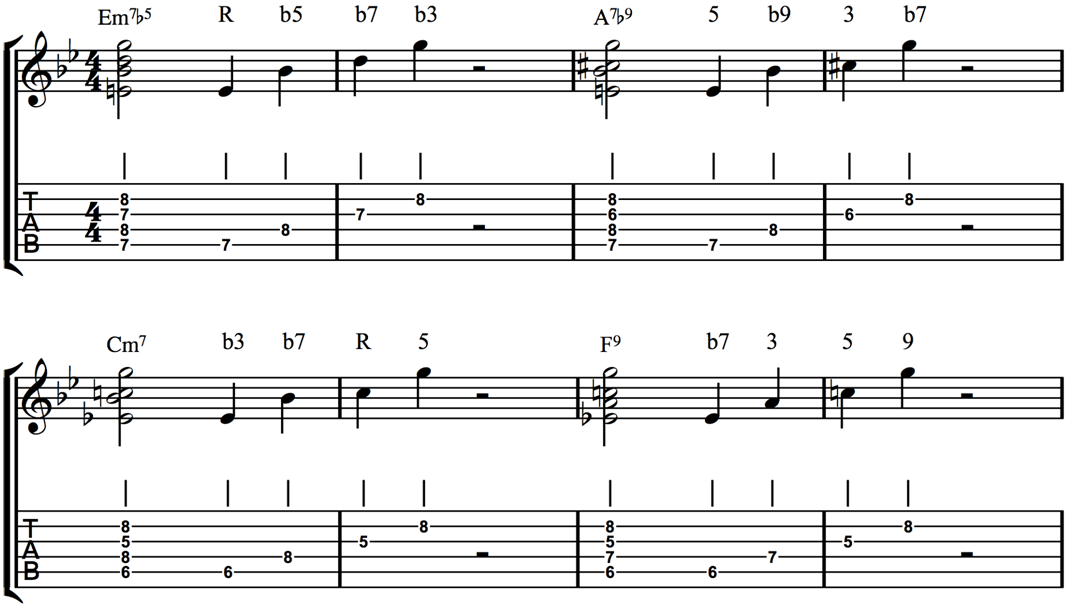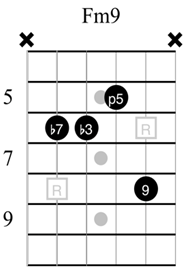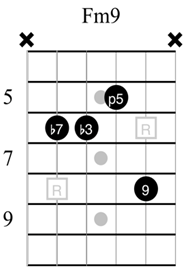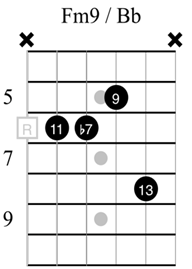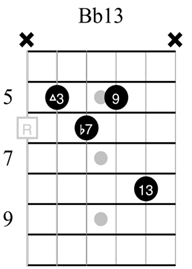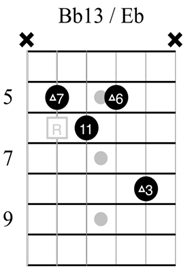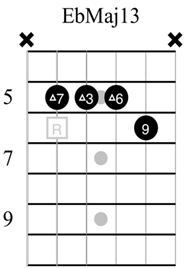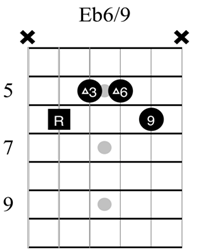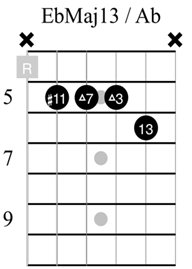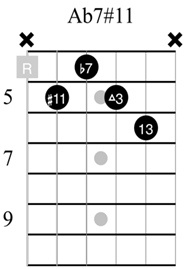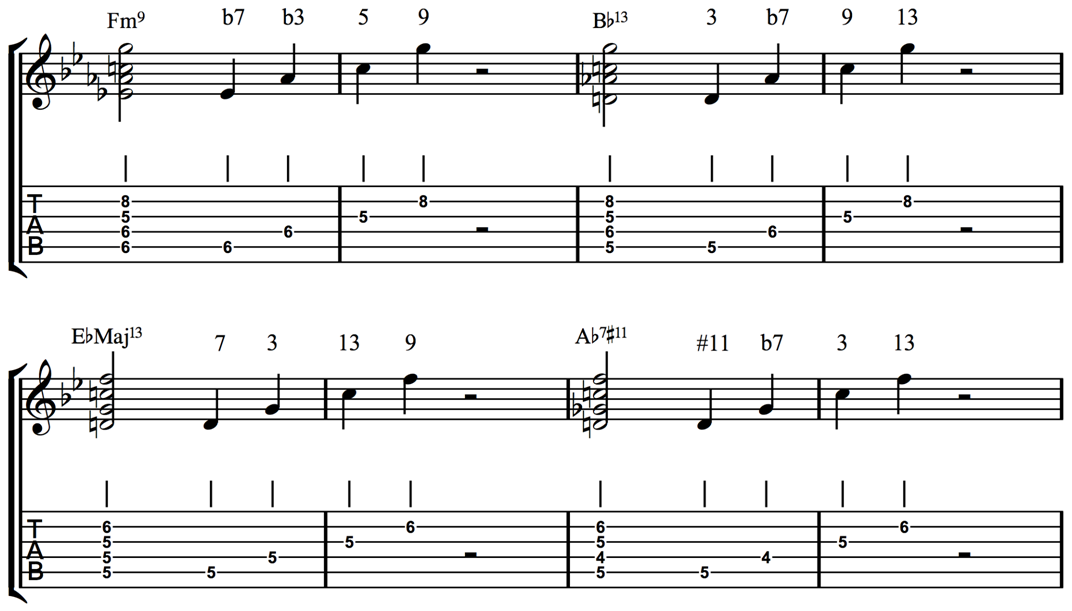Rootless Chord Voicings and Extensions for Guitar
This lesson on Chord Voicings is taken from voice leading jazz guitar. As I mentioned in the introduction, it is rarely necessary to play the root of the chord and often other intervals can be omitted too. The theory behind omitting notes is often taught academically and rigidly, with specific rules about which notes can be dropped in chord and when it is acceptable to do so. The truth is that there are no hard and fast rules about which notes must be included. More often than not, the listener will subconsciously ‘fill in the gaps’ when strong voice leading is used, even when an important note such as the 3rd is omitted.
By omitting the root and occasionally other intervals too, we can access other notes that add richness and interest to our chordal textures. Usually, when a note such as the root is left out, it is replaced by another note, either a natural extension (9th, 11th or 13th) or by a chromatic alteration (b9, #9, b5 or #5).
These extensions and alterations are covered in great detail in my books Guitar Chords in Context and Jazz Guitar Chord Mastery, but the following table shows the most common choices for jazz chords. This list isn’t exhaustive, extensions can be combined, and you should be aware of enharmonic notes such as a b5 being identical to the #11.
| Chord Type | Formula | Common Extensions |
| Maj7 | 1 3 5 7 | 9 #11 13 (or 6) |
| m7 | 1 b3 5 b7 | 9 11 |
| m7b5 | 1 b3 5 b7 | b9 9 11 |
| 7 (unaltered) | 1 3 5 b7 | 9 11 #11 13 |
| 7 (altered) | 1 3 (5) b7 | b9 #9 b5 (#11) #5 (b13) |
There are no ‘avoid’ notes, but 13ths (or 6ths) need to be handled with care on minor chords. Chord ii will normally contain a natural 13 whereas chords iii and vi contain b13s. Consider these as special cases and something to study later.
One important substitution to know is that Maj7 chords are often played as 6 or 6/9 chords on the guitar. For example, instead of playing EbMaj7 in bar seven of Bella by Barlight, it is common to hear Eb6 (1 3 5 6) or Eb6/9 (1 3 6 9). Piano players may use different formulas to play 6, and 6/9 chords but these voicings work well on the guitar. Sometimes the 7th can be included in a 6/9 chord if the root is omitted although technically this would be a Maj13th chord.
A dominant 7 chord acting as a functional V7 chord (for example in a ii V I progression) can normally take any level of tension you care to add, although certain situations may heavily suggest a specific tension. One tension that it is normally okay to add to any functional dominant is the b9. The b9 is normally substituted for the root and is probably the most common tension used in jazz.
The best way to learn these sounds is to study how they are used in rhythm guitar parts. The ‘rules’ of harmony are subjective, so if someone tells you about a rule of music, don’t discount it, but use it as a solid foundation from which to explore. Most things in music are about context; it is always possible to play something that would be considered a ‘wrong’ note by most theory experts if it is done at the right point in the song. This skill comes down to rhythm, phrasing and conviction.
The important thing to realise about any ‘altered’ note choices I use in this book is that they are not chosen at random. In other words, each note choice occurs because it provides good voice leading between chords.
Let’s study some ‘extension and alteration’ possibilities on the first four bars of Bella by Barlight.
We will begin with a common Em7b5 voicing.
In the previous chapter, two notes changed between the chords of Em7b5 and A7. Let’s look at how we can further reduce the amount of moving voices.
To refresh your memory, here are the first four bars of Bella by Barlight:
Despite the A7 not resolving to a D chord, it is still considered part of a ii V progression and will, therefore, accept some tension. Also, the melody of the original tune at this point contains a b9 note (Bb), so it can be appropriate to reflect that tension in the chord part.
The Em7b5 chord already contains the Bb note (on the fourth string), so instead of moving down to the root of the A7 chord (A) as before, we can leave it where it is and only move the b7 of Em7b5 down to become the 3rd of A7. This is easier to understand when seen it in the following diagram.
Chord voicings Example 2a:
We have simultaneously introduced a rich, beautiful alteration to the A7 chord while also reducing the number of moving voices to create a tight, efficient musical harmony.
As with any chord, there are many extensions that can be added to the following Cm7 although in this case my first choice would be to stick with the unaltered voicing from Chapter One as it continues the stepwise voice leading:
Chord voicings Example 2b:
Notice how the note on the third string falls by a semitone on each chord.
9ths can be freely added to most dominant 7 chords, and by adding a 9th to the following F7, we can move from Cm7 to F9 by changing just one note. In the following diagram, you can see how we replace root of the Fm7 chord (F) with the 9th (G):
The 9th of F7 (G) is same note as the 5th of the previous Cm7 chord (G), allowing this note to remain unchanged over both chords. As you can see, only one note now changes between Cm7 and F9. The b7 of Cm7 (Bb) falls to the 3rd of F9 (A).
Chord voicings Example 2c:
Of course, there are other extensions that could be used on the F7 chord, but right now we are focused on creating the smallest possible movements between chords.
Play through the first four bars of Bella’, paying careful attention to the voice leading on each string. As before, try to visualise each interval and note change before you play it. Strum each chord before picking each note in turn and saying the intervals out loud.
It is very important to get into the habit of ‘building’ each chord from its constituent intervals whenever you change chord. Try not to memorise shapes; build every chord note by note by first placing the root, then other intervals.
Chord voicings Example 2d:
We can continue in a similar vein for the next four bars.
In the previous bar of F7, the root was replaced by the 9th. As seen in the table on page 19, the 9th is a great interval to play on both the F7 and the Fm7 chord so let’s leave it where it is for now.
Now the only note that changes between F9 and Fm9 is the 3rd (A). It must fall by a semitone to become the b3 of Fm9 (Ab).
Chord voicings Example 2e:
The next chord is a functional Bb7 that resolves in the following bar to the tonic EbMaj7. Once again, we can form a Bb7 voicing by changing just one note from the previous Fm9.
The question to always ask ourselves when finding routes through chord sequences is “what does each interval in this chord become when played over the root note of the next chord?”.
The next diagram may look a little confusing at first, but it will help you to get ‘inside the head’ of a good jazz guitar player. The first diagram shows the intervals of Fm9 (the chord we are playing) over the root note of F. The second diagram shows the same notes, but this time they are viewed as intervals of Bb (the chord we are moving too).
Look at the second diagram and compare it with the table at the start of the chapter. Which notes are ‘acceptable’ in a Bb7 chord, and which need to change?
Well, the truthful answer is that they all could work well on the Bb7 chord. Playing this group of notes over a Bb bass note forms the chord Bb13sus4 (11 is the same as 4). We could continue playing this set of notes to create a tense harmony as the bass moves to Bb. However, at this point in the progression it is much stronger to hear the 3rd of the Bb7, so my suggestion is to drop the 11th to the 3rd in the following way:
It should be said that there are no ‘rights or wrongs’ here. You may wish to play the Bb13sus4 for a few beats before resolving to the Bb13.
As you can see, moving just one note of the Fm9 creates a rich, extended Bb13 chord that includes the 9th. Rootless voicings of chords are extremely useful on the guitar; by using just four notes we can create beautiful, advanced harmonies.
Remember: ask yourself on every chord change, ‘Which notes can stay the same, which notes need to move?’
Let’s move on to the EbMaj7 chord.
Look to see which intervals the notes of the current chord (Bb13) form against the Eb root note:
Refer back to the table. As you can see, the 7th, the 6th and the 3rd all work on an EbMaj7 chord, but the 11th will clash with the 3rd. The problem is that if we simply drop the 11th to the major 3rd, there will be two major 3rds in this chord voicings.
A good solution is to drop the 11th to the 3rd but also to drop the higher 3rd to the 9th creating a slightly unusual Maj13th chord (a Maj6 chord that includes the 7th):
Again, this is a rootless chord voicing that has slight tension due to the 7th in the bass. This is a great sound, but possibly a voicing to avoid if you’re working in a duo with an inexperienced singer. If you need to play the root as the lowest note then you could opt for a more standard Eb6/9 chord:
The final chord of this section is Ab7. In Bella by Barlight, it is often played as an A7#11 (or ‘Lydian Dominant’) chord. Once again, see what intervals the current EbMaj13 chord tones form against the root of the next Ab7#11 chord:
This chord voicing already contains three intervals we can use for Ab7#11. The only note that needs to change is the 7th, which must fall by a semitone to the b7 (Gb):
You may recognise this chord as a ‘Hendrix’ D7#9 shape, but over an Ab root it functions completely differently.
Recap the second four bars of Bella’, playing each chord and then its intervals.
Chord voicings Example 2f:
Play smoothly through the first eight bars of the song and visualise the root notes of any rootless voicings. Notice how the top note of each chord remains unchanged for the first six bars. Compare this sequence to how you used to play these chords.
Chord voicings Example 2g:
This lesson is just a small sample of my book Voice Leading Jazz Guitar.
“The artists you work with, and the quality of your work speaks for itself.”
Tommy Emmanuel
© Copyright Fundamental Changes Ltd 2025
No.6 The Pound, Ampney Crucis, England, GL7 5SA

